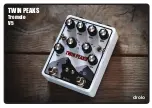
244 B: More About Calculations
File name : English-M02-1-040308(Print).doc Print data : 2004/3/9
restart the search.
Case 2:
The calculator displays the values of
LEFT
and
RIGHT
, which
are unequal. To see the calculator’s result, press
<
or
C
. If
LEFT
and
RIGHT
are relatively close to one another in value, the result is
probably a true solution. Otherwise, the result is probably not a true
solution.
If the result seems unreasonable, it could be because the equation has
more than one solution. You might want to enter one or two guesses
and restart the search.
If you want to obtain additional information about the answer, press
and hold down the menu key for the unknown variable until the numbers
in the display stop changing. At this point, the Solver is displaying the
final estimates and the signs of
LEFT
-
RIGHT
for each estimate.
This information can be helpful:
Case 2a:
If the signs of
LEFT
-
RIGHT
are opposite, and the two
estimates are as close together as two 12-digit numbers can get
(neighbors), the Solver found two estimates that “bracket” an
ideal solution (a solution where
LEFT
-
RIGHT
equals zero). If
LEFT
and
RIGHT
are relatively close together, the answer is probably a
solution.
Case 2b:
If the signs of
LEFT
-
RIGHT
are opposite, and the two
estimates are not neighbors, be very cautious about accepting the
answer as a solution. If
LEFT
and
RIGHT
are relatively close
together, the answer is probably a solution.
Case 2c:
If
LEFT
-
RIGHT
for the two estimates have the same sign,
the Solver has halted because it could find no estimates that
further reduced the magnitude of
LEFT
-
RIGHT
. Be very cautious
about accepting the answer. If the values of
LEFT
and
RIGHT
are
not relatively close to one another, you should reject the answer.










































